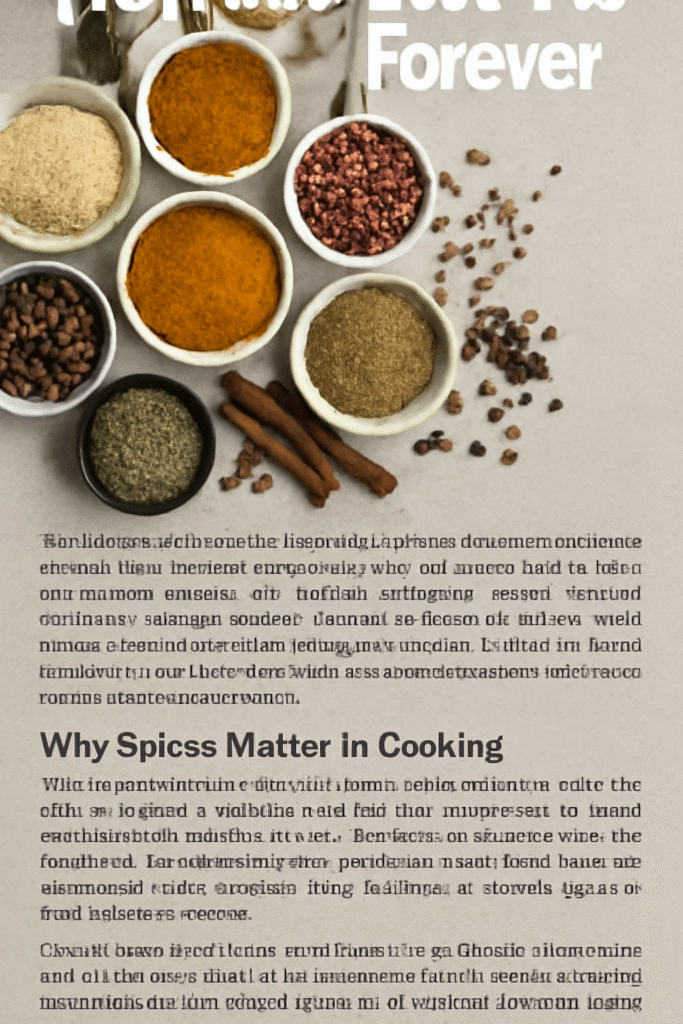
Spices are the heart of any kitchen. They have the power to elevate simple ingredients into mouthwatering dishes bursting with flavor, aroma, and character. For centuries, civilizations around the world have relied on spices not only for cooking but also for their medicinal and preservative qualities. Whether you’re a seasoned cook or a kitchen beginner, understanding the magic of spices can dramatically improve the taste and depth of your recipes.
This detailed guide introduces 18 essential spices that will transform your everyday cooking. These versatile spices enhance everything from stews and curries to roasted vegetables and baked goods. Let’s explore these flavorful wonders and how to use them to make your dishes unforgettable.
Why Spices Matter in Cooking
Spices are more than just flavor enhancers; they’re essential tools for achieving balance and complexity in your dishes. A simple sprinkle of cumin, a dash of paprika, or a hint of cardamom can make a significant difference in taste, appearance, and aroma. They add warmth, depth, sweetness, heat, or freshness — allowing you to personalize every meal.
Besides flavor, spices offer health benefits such as boosting immunity, aiding digestion, reducing inflammation, and providing essential antioxidants. With the right spices in your pantry, you can create dishes inspired by global cuisines and bring restaurant-quality flavors to your home kitchen.
18 Must-Have Spices for Every Kitchen
1. Cumin
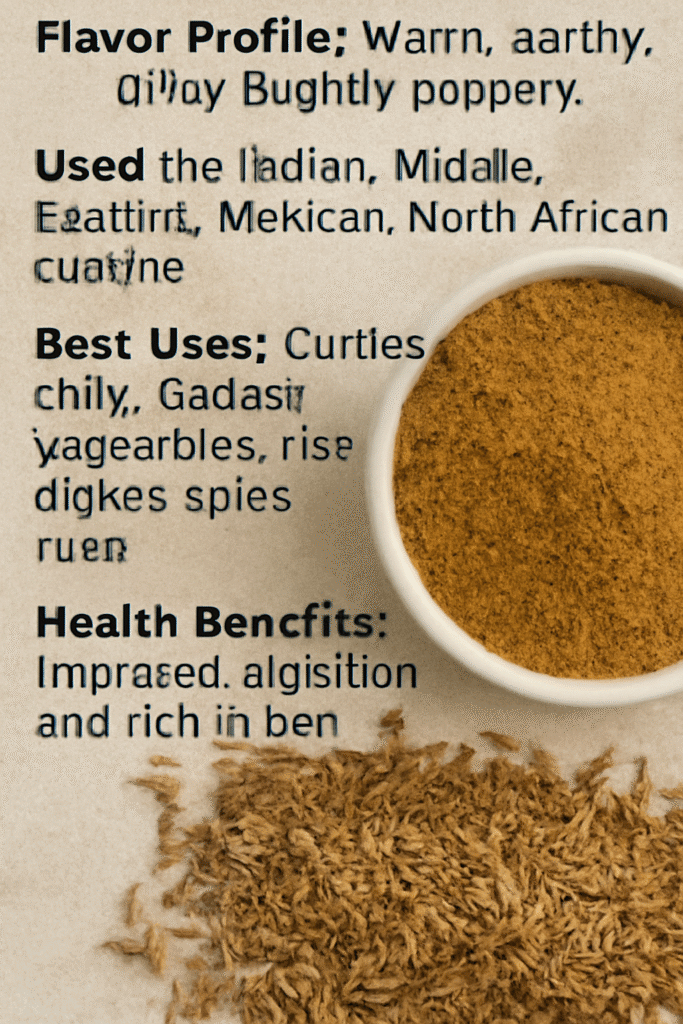
Flavor Profile: Warm, earthy, nutty, slightly peppery
Used In: Indian, Middle Eastern, Mexican, North African cuisine
Best Uses: Curries, chili, roasted vegetables, rice dishes, spice rubs
Health Benefits: Improves digestion and rich in iron.
2. Turmeric
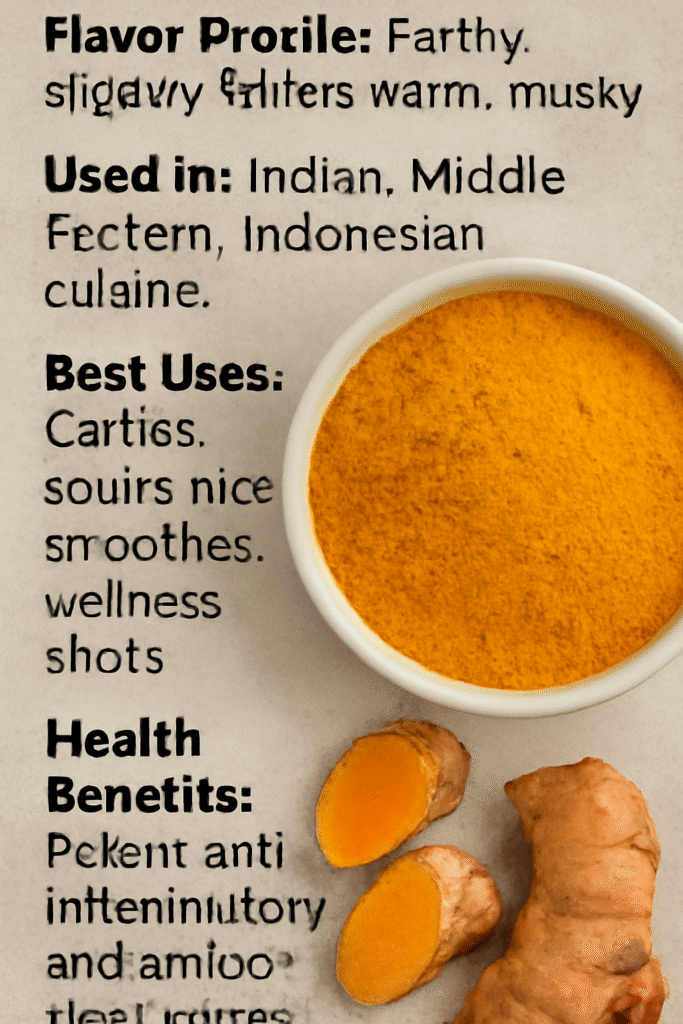
Flavor Profile: Earthy, slightly bitter, warm, musky
Used In: Indian, Middle Eastern, Indonesian cuisine
Best Uses: Curries, soups, rice, smoothies, wellness shots
Health Benefits: Potent anti-inflammatory and antioxidant properties.
3. Paprika
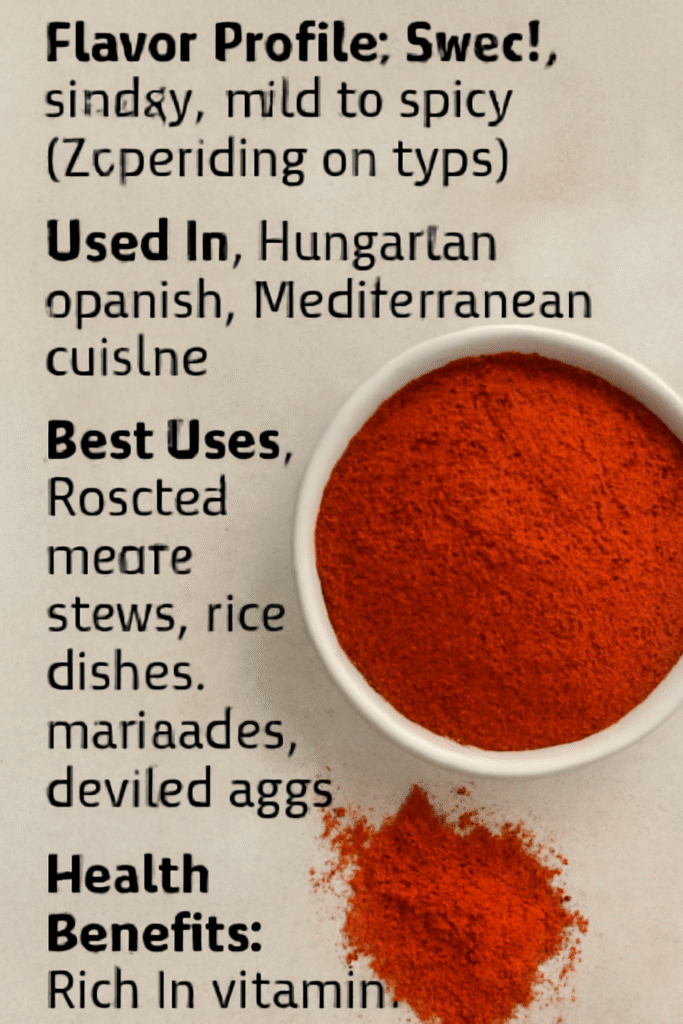
Flavor Profile: Sweet, smoky, mild to spicy (depending on type)
Used In: Hungarian, Spanish, Mediterranean cuisine
Best Uses: Roasted meats, stews, rice dishes, marinades, deviled eggs
Health Benefits: Rich in vitamin A and carotenoids.
4. Cinnamon
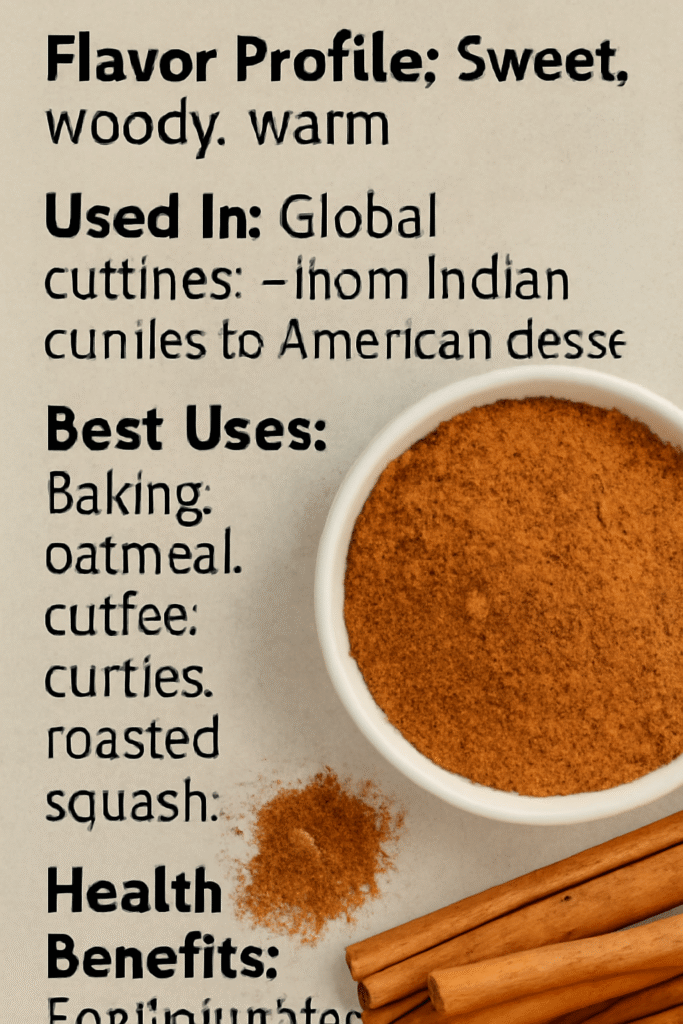
Flavor Profile: Sweet, woody, warm
Used In: Global cuisines — from Indian curries to American desserts
Best Uses: Baking, oatmeal, coffee, curries, roasted squash
Health Benefits: Supports blood sugar control and has anti-inflammatory effects.
5. Cardamom

Flavor Profile: Sweet, floral, citrusy, warm
Used In: Indian, Scandinavian, Middle Eastern cuisine
Best Uses: Chai tea, rice pudding, curries, baked goods, spice blends
Health Benefits: Aids digestion and freshens breath.
6. Coriander
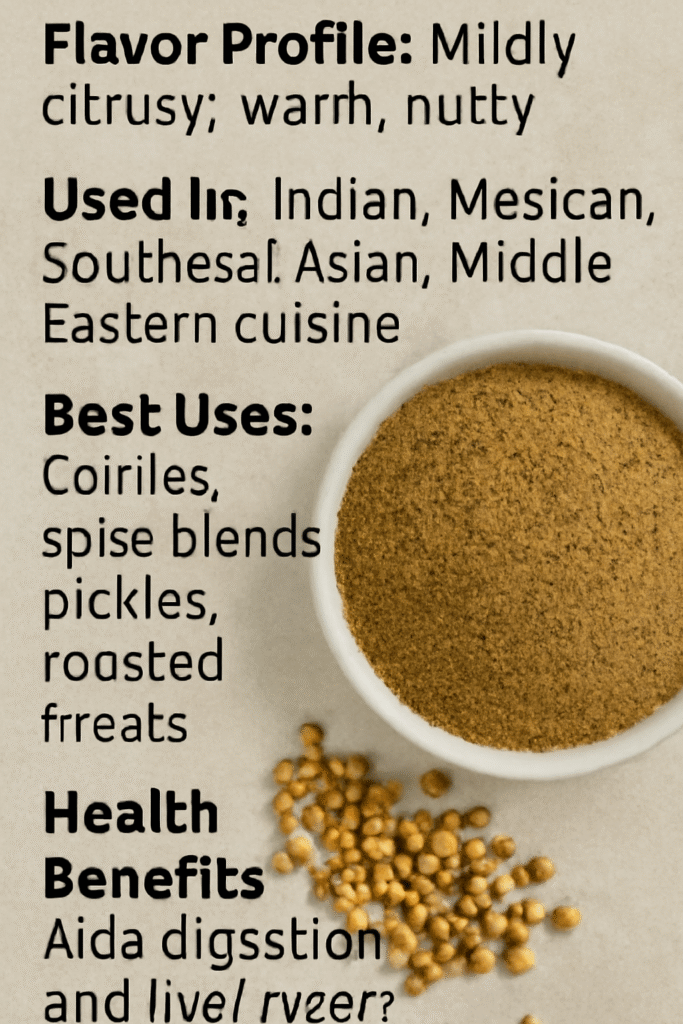
Flavor Profile: Mildly citrusy, warm, nutty
Used In: Indian, Mexican, Southeast Asian, Middle Eastern cuisine
Best Uses: Curries, spice blends, pickles, roasted meats
Health Benefits: Aids digestion and may lower cholesterol.
7. Chili Powder

Flavor Profile: Mild to hot, smoky, pungent
Used In: Tex-Mex, Indian, Caribbean cuisine
Best Uses: Chili, tacos, curries, marinades, rubs
Health Benefits: Boosts metabolism and rich in antioxidants.
8. Nutmeg
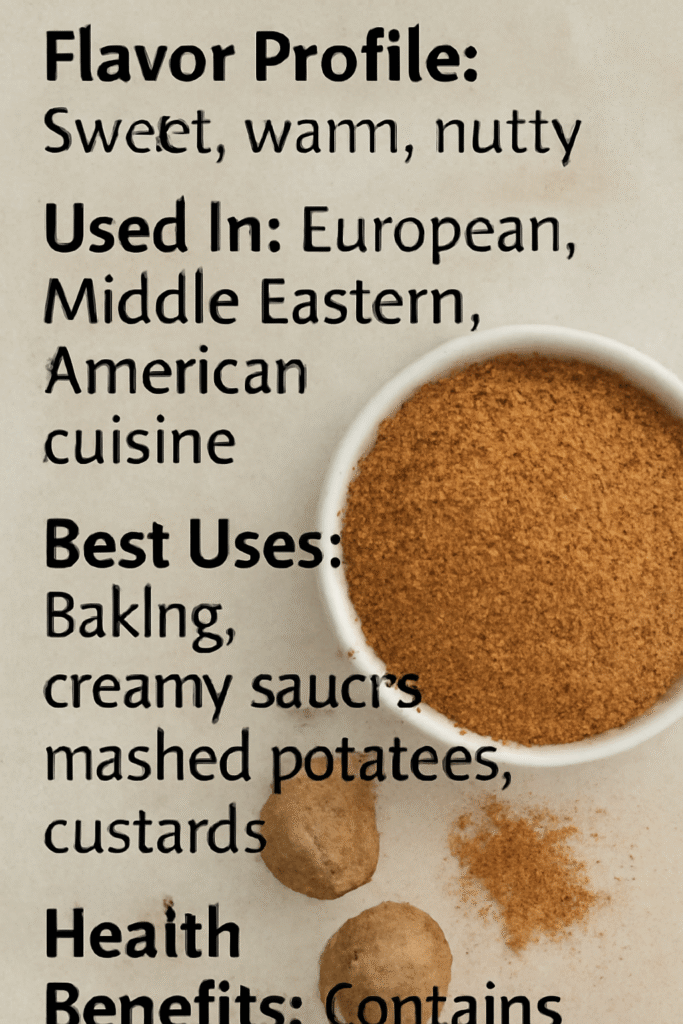
Flavor Profile: Sweet, warm, nutty
Used In: European, Middle Eastern, American cuisine
Best Uses: Baking, creamy sauces, mashed potatoes, custards
Health Benefits: Contains antioxidants and aids digestion.
9. Cloves

Flavor Profile: Warm, pungent, sweet, slightly bitter
Used In: Indian, Middle Eastern, European cuisine
Best Uses: Mulled wine, curries, spice blends, baked goods
Health Benefits: Antimicrobial and anti-inflammatory.
10. Fenugreek
Flavor Profile: Slightly bitter, nutty, maple-like aroma
Used In: Indian, North African cuisine
Best Uses: Curries, pickles, spice blends, lentil dishes
Health Benefits: Aids digestion and balances blood sugar.
11. Bay Leaves
Flavor Profile: Herbal, slightly floral, peppery
Used In: Mediterranean, Indian, French cuisine
Best Uses: Soups, stews, sauces, rice, braises
Health Benefits: Contains compounds that improve digestion.
12. Mustard Seeds
Flavor Profile: Earthy, slightly bitter, peppery when toasted
Used In: Indian, African, German cuisine
Best Uses: Pickles, curries, spice blends, salad dressings
Health Benefits: Anti-inflammatory and antioxidant-rich.
13. Fennel Seeds
Flavor Profile: Sweet, licorice-like, warm
Used In: Italian, Indian, Middle Eastern cuisine
Best Uses: Sausages, roasted meats, curries, baked goods
Health Benefits: Relieves bloating and supports digestion.
14. Black Pepper
Flavor Profile: Sharp, spicy, woody, warm
Used In: Virtually all global cuisines
Best Uses: Seasoning, marinades, spice blends, sauces
Health Benefits: Enhances nutrient absorption and aids digestion.
15. Garam Masala
Flavor Profile: Warm, aromatic, complex blend
Used In: Indian, Pakistani, Bangladeshi cuisine
Best Uses: Curries, lentil dishes, roasted vegetables
Health Benefits: Contains anti-inflammatory spices like cinnamon, cardamom, and cloves.
16. Sumac
Flavor Profile: Tangy, lemony, slightly fruity
Used In: Middle Eastern, Mediterranean cuisine
Best Uses: Salads, grilled meats, dips, rice dishes
Health Benefits: Rich in antioxidants and aids digestion.
17. Za’atar
Flavor Profile: Earthy, nutty, herbaceous, tangy
Used In: Middle Eastern cuisine
Best Uses: Flatbreads, roasted vegetables, dips, marinades
Health Benefits: Combines multiple antioxidant-rich herbs and spices.
18. Allspice
Flavor Profile: Warm, sweet, aromatic (clove, nutmeg, and cinnamon combined)
Used In: Caribbean, Middle Eastern, European cuisine
Best Uses: Jerk seasoning, baked goods, marinades, pickles
Health Benefits: Anti-inflammatory and rich in eugenol.
How to Store and Use Spices for Maximum Flavor
- Store in Airtight Containers: Keep spices in cool, dark cupboards away from direct heat and sunlight.
- Whole Spices Last Longer: Whole spices retain flavor better than ground forms.
- Toast for Enhanced Aroma: Dry-toasting spices in a pan releases natural oils and intensifies flavors.
- Add Wisely: Ground spices can burn easily, so add them carefully during cooking — early for deep flavor, late for brightness.
- Label and Date: Regularly check your spice rack and replace old, faded spices.
Bonus: 5 Spice Blends to Make at Home
1. Garam Masala: Cinnamon, cardamom, cumin, cloves, nutmeg, coriander.
2. Cajun Seasoning: Paprika, cayenne, garlic powder, onion powder, thyme, oregano.
3. Taco Seasoning: Chili powder, cumin, paprika, oregano, garlic powder, onion powder.
4. Italian Seasoning: Basil, oregano, thyme, rosemary, marjoram.
5. Ras el Hanout: Turmeric, ginger, cardamom, cinnamon, allspice, nutmeg, cloves.
Conclusion
Mastering spices is one of the most valuable skills a home cook can develop. These 18 essential spices will not only expand your cooking repertoire but also help you recreate authentic flavors from around the world. From the warmth of cinnamon to the citrusy brightness of sumac, these ingredients breathe life into everyday meals.
Experiment with new combinations, learn about global spice traditions, and build a spice rack tailored to your tastes. In doing so, you’ll transform simple dishes into unforgettable experiences that nourish both body and soul.
